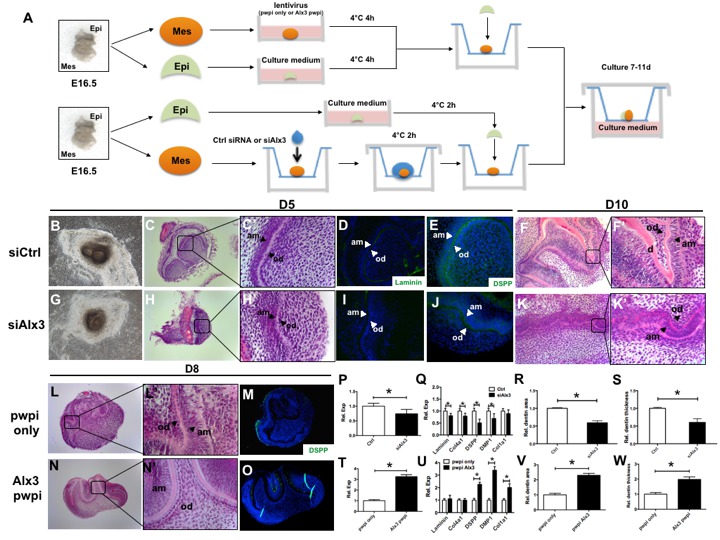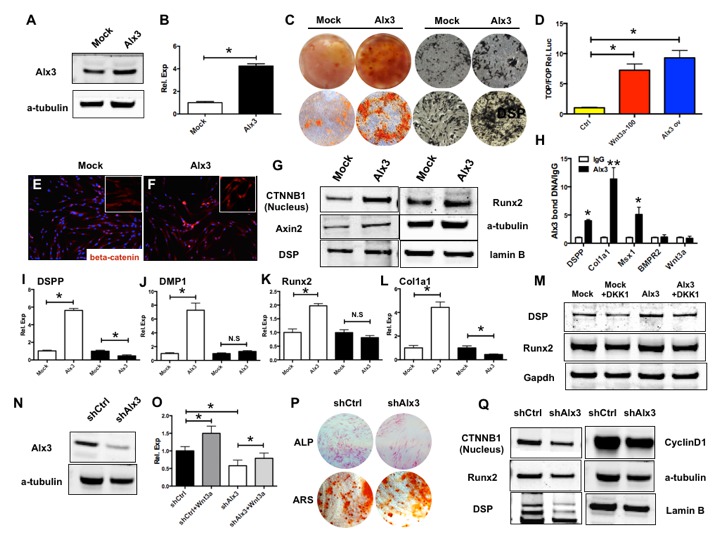IADR Abstract Archives
Dental Pulp/Dentin Regeneration by Alx3 via Wnt/β-catenin Signaling
Objectives: Alx3 is a transcription factor with robust expression in dental mesenchyme in early tooth development, and yet its functional roles are elusive. The purpose of this study is to map Alx3 expression and determine Alx3 functions in tooth development and regeneration.
Methods: Molar tooth organs were isolated from E16.5 mouse embryos and microdissected into epithelium and mesenchyme. Alx3 was over-expressed in dental mesenchyme by or knocked down, followed by recombination with dental epithelium and organ-culture. Dental pulp stem/progenitor cells were harvested from adult human third molars following IRB approval, and tested for odontoblastic differentiation upon Alx3 overexpression or knockdown by alizarin red, von kossa, quantitative real-time PCR and Western Blot, with or without DKK1, a Wnt family inhibitor. Alx3 binding targets were identified with ChIP assay. All quantitative data were treated with ANOVA and Bonferroni with α value at 0.05.
Results: Alx3 overexpression in dental mesenchyme increased dentin volume, in addition to enhanced DSPP, DMP1 and Col1a1 expression. Conversely, Alx3 knockdown not only disrupted basement membrane formation, including attenuated laminin and Col IV synthesis, but also abolished polarization of both ameloblasts and odontoblasts, leading to significantly reduced dentin volume. Alx3 overexpression in DPSCs enhanced alizarin red and von kossa staining, along with significantly increased DSPP, Runx2 and Ocn expression. Alx3 induced robust β-catenin transnucleation at a capacity benchmarked to Wnt3a (100 ng/mL), a canonical Wnt ligand. DKK1, a Wnt antagonist, significantly attenuated DSPP, DMP1 and Col1a1. ChIP assay showed Alx3 binding to DSPP and Col1a1 promoters, suggesting that Alx3 directly promotes odontoblastic differentiation. Conversely, Alx3 knockdown with shRNA attenuated DSPP, DMP1, Runx2, CTNNB1 and collagen1a1.
Conclusions: Alx3 plays significant roles in dental pulp and dentin development. Postnatally, Alx3 directly mediates DSPP, a crucial gene in odontoblastic differentiation and/or indirectly through Wnt/β-catenin signaling, both with strong implications in dental pulp and dentin regeneration.
Methods: Molar tooth organs were isolated from E16.5 mouse embryos and microdissected into epithelium and mesenchyme. Alx3 was over-expressed in dental mesenchyme by or knocked down, followed by recombination with dental epithelium and organ-culture. Dental pulp stem/progenitor cells were harvested from adult human third molars following IRB approval, and tested for odontoblastic differentiation upon Alx3 overexpression or knockdown by alizarin red, von kossa, quantitative real-time PCR and Western Blot, with or without DKK1, a Wnt family inhibitor. Alx3 binding targets were identified with ChIP assay. All quantitative data were treated with ANOVA and Bonferroni with α value at 0.05.
Results: Alx3 overexpression in dental mesenchyme increased dentin volume, in addition to enhanced DSPP, DMP1 and Col1a1 expression. Conversely, Alx3 knockdown not only disrupted basement membrane formation, including attenuated laminin and Col IV synthesis, but also abolished polarization of both ameloblasts and odontoblasts, leading to significantly reduced dentin volume. Alx3 overexpression in DPSCs enhanced alizarin red and von kossa staining, along with significantly increased DSPP, Runx2 and Ocn expression. Alx3 induced robust β-catenin transnucleation at a capacity benchmarked to Wnt3a (100 ng/mL), a canonical Wnt ligand. DKK1, a Wnt antagonist, significantly attenuated DSPP, DMP1 and Col1a1. ChIP assay showed Alx3 binding to DSPP and Col1a1 promoters, suggesting that Alx3 directly promotes odontoblastic differentiation. Conversely, Alx3 knockdown with shRNA attenuated DSPP, DMP1, Runx2, CTNNB1 and collagen1a1.
Conclusions: Alx3 plays significant roles in dental pulp and dentin development. Postnatally, Alx3 directly mediates DSPP, a crucial gene in odontoblastic differentiation and/or indirectly through Wnt/β-catenin signaling, both with strong implications in dental pulp and dentin regeneration.


